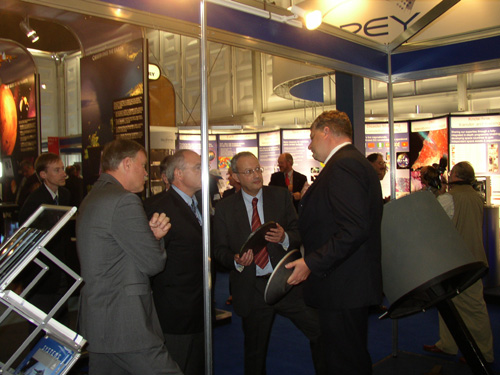Lightweight Active and Passive Carbon Fibre Mirrors
Optical Science Laboratory
Project Background
NEWS - Journal paper accepted for publication in Optical Engineering... Read the abstract here
![]()
![]()

The overall aim of the project is to design, build and test an active mirror using nickel-coated carbon fibre-reinforced polyester (CFRP).
It is a collaboration between UCL’s Optical Science Laboratory, Qinetiq and Cobham Composites, and is funded by the Particle Physics and Astronomy Research Council (PPARC) under the PPARC Industrial Support Scheme (PIPSS).
The mirror development breaks down into 2 stages: (i) the manufacture of a passive test mirror; and (ii) design, manufacture and testing of a deformable mirror. The purpose of the first stage was to get to grips with the manufacturing technique, look at polishing issues and identify problems that were likely to complicate the active mirror design.
The following sections will outline some of the many applications of this technology, as well as some info about the mirror's design. To find out more about carbon fibre composite materials, go to the Composites page.
Space systems often have to operate under a wide range of conditions.
First, they must be able to withstand the various gravity regimes they will encounter. The systems' manufacture here on Earth occurs at 1g. During launch the craft can experience forces up to 5g, and once in space operation is at 0g. For an optical system to function optimally under these varying forces it must either be very stiff or adjustable. An active carbon fibre mirror can provide an excellent stiffness to weight ratio.
Second, a spacecraft will be exposed to extreme thermal conditions in space. A mirror must be able to hold its shape over a wide range of temperatures. Whilst carbon fibre material displays excellent thermal stability, an active support system can further adjust the mirror's shape to correct for any deformations.
Third, and perhaps most importantly, the cost of a space mission is strongly connected to the payload weight. If an imaging system can be lightweighted this means cost saving or a larger payload at the same price.
Carbon fibre imaging systems could therefore be very useful in commercial or military imaging satellites, unmanned aerial vehicles (UAV's) or space-borne telescopes.
The next generation of astronomical telescopes that's currently on the drawing board will have primary mirrors measuring 30 - 100 m in diameter. These projects represent huge challenges for managers, astronomers and engineers alike. To get the maximum return from such extremely large telescopes (ELTs) they must be capable of diffraction-limited imaging over a significant fraction of the sky with a large corrected field of view (arcminutes rather than arcseconds).
To compensate for the degrading effect of the Earth's atmosphere astronomers make use of adaptive optics (AO) systems that sense the incoming wavefront, analyse the distortions and correct the light using a deformable or 'bendy' mirror. The systems currently in use, however, are often very complex and limited by small field of view and limited sky coverage.
To improve the integration of AO system into the telescope's operation one of its main mirrors, such as the secondary, can be made adaptive. A lot of work has been done here at UCL into these adaptive secondary mirrors (see the OSL Research page). This approach reduces IR emissivity, increases photon throughput and minimises the number of reflective surfaces in the optical system.
As the secondary mirror of a 30 - 100 m class telescope is likely to measure 4-8 m itself and will be suspended high above the primary in its cell, the advantages of using a lightweight, durable and robust material such as carbon fibre composite are clear.
The main design parameters of the test mirror were taken from those of the aluminium adaptive secondary demonstrator that was previously developed at UCL (click here to learn more about this project), so that some of the hardware could be reused and a performance comparison made.
The aluminium adaptive mirror measures 270 mm in diameter, has a radius of curvature of 2945 mm and its shape is controlled by 7 magnetostrictive actuators in a hexagonal arrangement, spaced 100 mm apart.
The carbon fibre active mirror was designed to the same specifications, the main differences being the faceplate material and thickness. To provide a reflective surface a thin nickel coating was included.
Farnborough International Airshow
The CFC passive mirror was on display on the Smart Optics stand in the International Space Hall at the 2004 Farnborough International Airshow. The picture below shows Lord Sainsbury taking a look...

